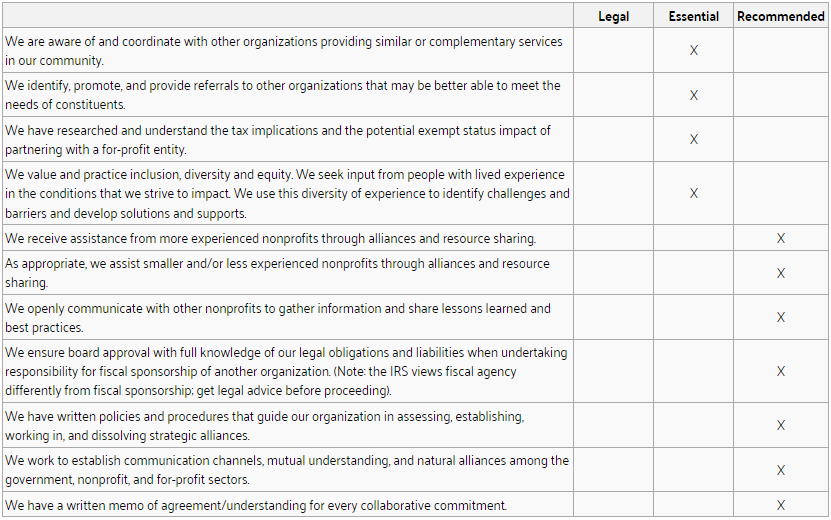Guidelines and Principles
Strategic Alliance
Strategic alliances can take many forms and can serve multiple purposes, such as partnership, sharing of resources and improved operational efficiency. Strategic alliances help to strengthen individual nonprofit capacity and the capacity of the sector as a whole. Nonprofit organizations should be open to strategic alliances and, when appropriate, should partner with other organizations to enhance their capability to achieve desired results. Nonprofits should work to promote cooperation and coordination among a variety of entities to avoid unproductive duplication of services and to maximize the resources available to the communities they serve.
Assessment Items
Assessment

Relationship Building

Resources
- Fiscal sponsorship policy & procedures
- Joint venture policy
- Written memo of agreement/understanding for each collaborative commitment
Best Practices
Assessment
- Seriously consider collaborative ventures with natural partners for program implementation. Also consider the possibilities of formal alliances and/or mergers as appropriate. Ideally, your board of directors should be open to consolidating or merging with other organizations if it would be in the best interest of our constituents, community, or service area. Effective use of resources through cost-sharing mechanisms will allow a greater level of financial support to direct services.
- Where formal partnerships exist, be thoughtful about the natural life of the relationship. Decide when and how relationships will be evaluated and/or terminated. Consider formal partnership agreements—particularly when sharing financial resources—that make provisions for both intellectual and real property when the relationship ends.
Relationship Building
- Make it a habit to communicate regularly with current, past and potential funders. Add them to your mailing list for newsletters, annual reports and e-bulletins. Keep them apprised of significant happenings in your organization. Make it a point to network with key representatives at conferences and trainings.
- Communicate regularly with other organizations in your area. Share information and resources to establish your organization as one who is invested in improving the community rather than competing. Keep abreast of activities and events that impact your (and their) work. Consider participating in (or establishing) director’s networking breakfasts or brown bag lunch conversation circles.
- Identify key contacts with local government units (city, state, county, various departments) and business leaders to keep them apprised of your efforts. Add contacts to your newsletter mailing list or email alert system. Schedule breakfast or lunch meetings that will help you build a relationship before there’s an issue to address. Discuss mutual goals as well as opportunities for partnership and collaboration.
